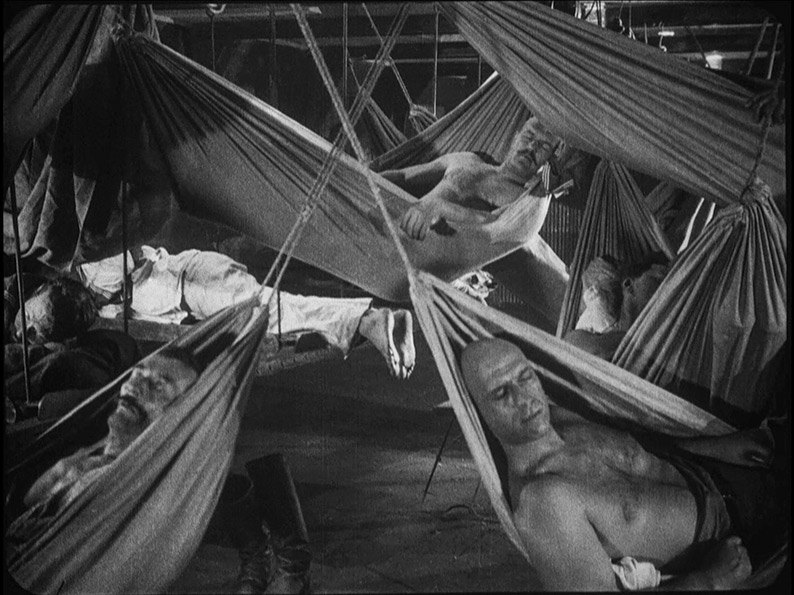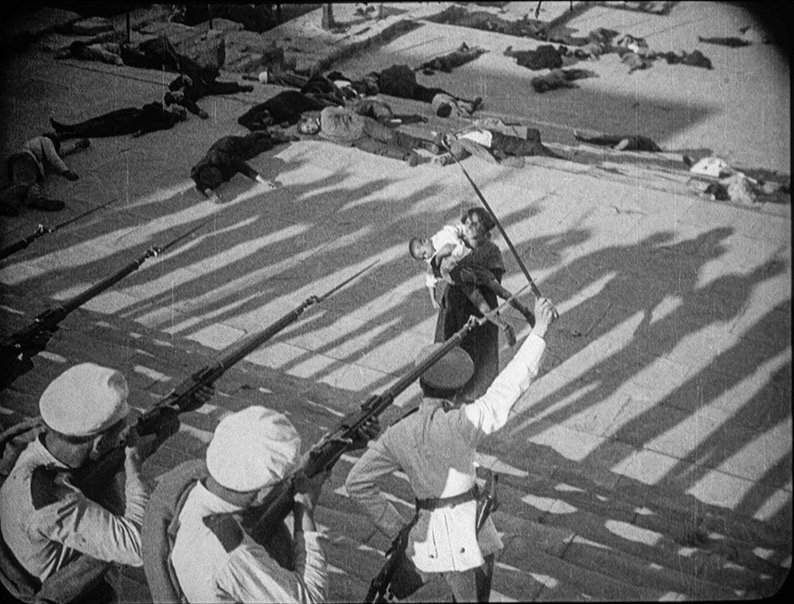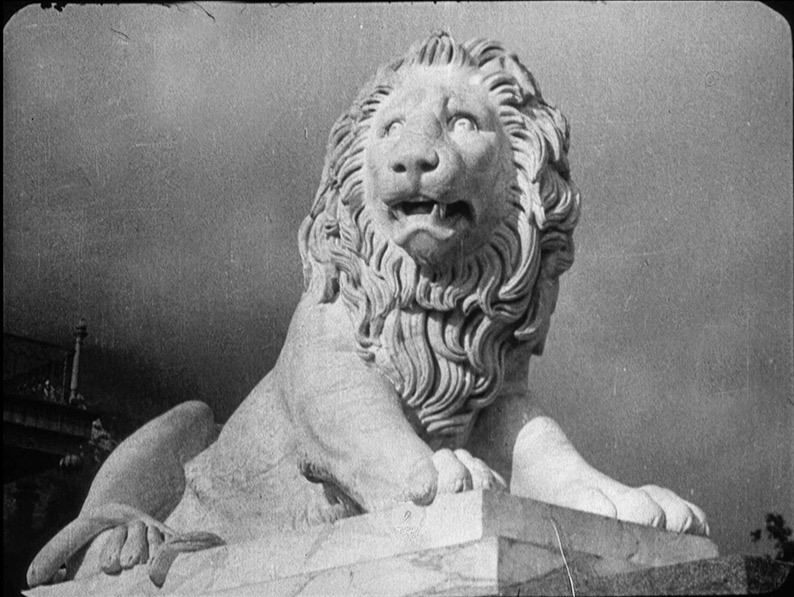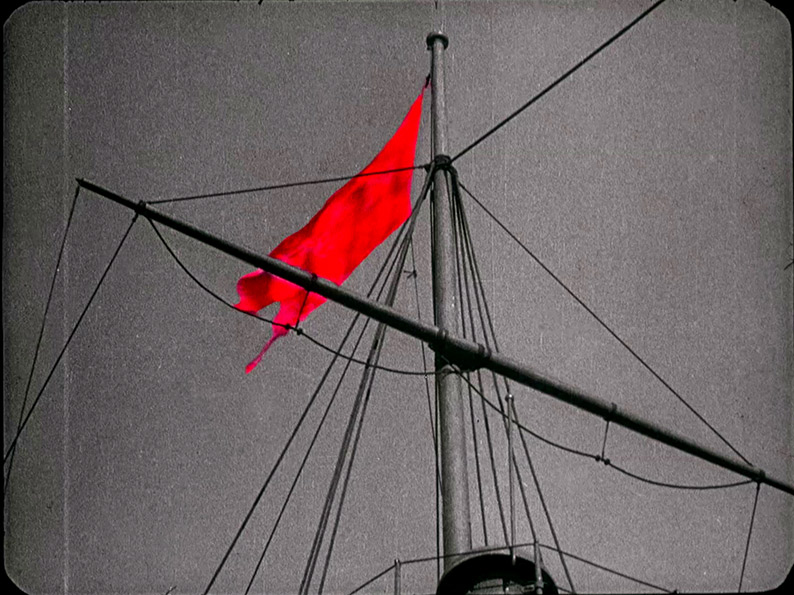|
June 1905, on the Potemkin, a battleship of the Imperial Russian Navy’s Black Sea fleet. Back home the first Russian Revolution is underway and crew members discuss the need to support this. Complaints by the sailors that their food is poor quality and maggot-ridden are ignored by the officers. When protesting sailors are sentenced to death, an uprising begins. The battleship, now controlled by the sailors, travels to the port of Odessa, whose citizens are roused to fury against the Tsar and his government. But soon there is retribution...
Some films have reached such a pitch of fame that you wonder if there is anything left to say about them, unless you want to be iconoclastic and set out to knock them. Battleship Potemkin (Bronenosets “Potyomkin”) is just such a film, and a textbook cinema classic if ever there was one. A hundred years after it was made, it’s hard to see Sergei Eisenstein’s second feature afresh, not just for the one-of-the-greatesr-of-all-time baggage it carries but also because it has been so influential on other filmmakers. The film’s fourth chapter of five, the massacre on the Odessa Steps, is among the single most celebrated sequences in cinema history. (To name just two examples: Brian De Palma directly referenced it in The Untouchables and Woody Allen parodied the three-shot sequence of a stone lion seemingly roused to fury in Love and Death.) So, not much that anyone can add? We can but try our best.

Potemkin has no characters as such, though maybe the mutineers make up a collective character. They are faces and bodies, objects in Eisenstein and his cinematographer Eduard Tisse’s compositions. Eisenstein and Tisse frequently display a penchant for composing along diagonal lines, something which they took to almost abstract extremes in later films such as Eisenstein’s final one, the two-part Ivan the Terrible. However, the film epitomises Eisenstein’s and other’s theory of montage. This abounded in Soviet films of the period, including works by his contemporaries Vsevolod Pudovkin, Dziga Vertov and others. While critics like André Bazin extolled long takes and deep focus, allowing the viewer to find their own way through what was on the screen, as exemplified by the works of Jean Renoir and others, montage was a different principle. Taking its cue from the formalist art movement, it sought meaning in clash and contrast, in editing back and forth. Many of the Soviet films used the techniques to overtly propagandist ends, and while filmmakers the world over excitedly took note of these developments from the recently-created Soviet Union, the powers that be were apprehensive. Some of these films attracted the attention of censors, Potemkin in particular.
The film came about when the All-Russian Central Executive decided that a film should be made for the twentieth anniversary of the first Russian Revolution. Potemkin was intended to be just one part of this, hence the opening-credit subtitle “From the Series ‘The Year 1905’”. The script was written by N.F. (Nina) Agadzhanova-Shutko and twenty-seven-year-old Sergei Eisenstein, whose previous feature film was Strike (1924), was assigned to direct. Originally the Potemkin mutiny would have been one of eight episodes, but time constraints meant that Eisenstein abandoned the rest and expanded the story to its present feature length. The film was shot where the story took place, in Odessa (now Odesa, Ukraine) where film facilities existed and, as a port city, a warship could be utilised. Production began at the end of March 1925 and the film was first shown on 21 December, with its premiere taking place on 18 January 1926. While musical accompaniment to silent films (from solo pianists to full orchestras) had been around since the beginning of cinema, for a silent to have a specially-composed score was less common. However, Potemkin had one, composed by Edmund Meisel, which added greatly to the film’s effect. Eisenstein certainly thought so, hiring him again for his next film, October (1927).
Douglas Fairbanks and Mary Pickford saw Potemkin during a trip to Moscow in July 1926 and enthusiastically reported back, helping to have the film distributed in the USA and inviting Eisenstein to Hollywood. However, in the UK it was a different story. The right wing looked at the situation in Russia (before the Soviet Union was formed in 1922) with some nervousness and even identified the then Labour Party with the Russian Bolsheviks. The General Strike of 1926 meant that films such as Potemkin and Pudovkin’s Mother (1926), overt calls to revolution and arms, would not find favour. Both of these films were duly banned by the British Board of Film Censors. The examiner who saw Potemkin was Colonel John C. Hanna, who had served in the army in India and Ireland and was certainly no revolutionary firebrand. Nor was the then Conservative Home Secretary Sir William Joynson-Hicks, who disapproved of the cinema in any form. This was a time when the BBFC went out of its way to remove current politics from the light of British projector carbon-arcs, and Potemkin was banned on 30 September 1926. Submissions to the London County Council and Middlesex County Council (local authorities then and now have the power to overrule the BBFC’s decisions) by the Communist film producer Ivor Montagu to allow the film’s showing in their areas were unsuccessful. The would-be distributors even received a visit from Scotland Yard and an edict that no showings, even to private clubs (which were not subject to BBFC censorship), would be allowed without the approval of Joynson-Hicks, which needless to say never happened.

That may have been it for a while. However, in 1925 Montagu and the similarly left-leaning Adrian Brunel had formed The Film Society, which aimed to show to the London cinema audiences important films which may not be available otherwise. As a cinema club (membership originally a guinea a year), it could show films which had not been passed by the BBFC, with local authority permission. Sometimes it did so: the Society held the British premiere of F.W. Murnau’s Nosferatu, despite a BBFC ban and the best efforts of Bram Stoker’s widow to have the film destroyed, due to its copyright infringement of her husband’s novel Dracula. Eventually Montagu and Brunel obtained a print of Potemkin from the Soviet trade delegation in Berlin. The LCC did not raise any objection to its being shown, and Potemkin had its British premiere at the Tivoli cinema in The Strand on Sunday 10 November 1929. That was a particularly famous Film Society afternoon as also on the programme was John Grierson’s Drifters, highly influential on the British documentary movement of the following decade. (Also shown were shorts before each film, a 1926 avant-garde take on The Fall of the House of Usher and the Mickey Mouse cartoon Barn Dance.) Eisenstein was present, and later gave a series of lectures. Meisel conducted his own score.
However, the ban remained in place, although Potemkin was in 16mm distribution from 1934. There are a handful of other showings on record before World War II at film societies, it did not play in London again until 1936. However, the film’s artistic reputation grew. In Sight and Sound’s inaugural once-a-decade Greatest Films of All Time poll in 1952, Potemkin placed fourth, behind Bicycle Thieves and a Chaplin tie for second place of City Lights and The Gold Rush. The film remained in the top ten in every poll until 2012, when it placed eleventh. In 2022 it placed fifty-fourth. The BBFC finally passed Potemkin in 1954, uncut for an X certificate, which then restricted audiences to over-sixteens. By then, its standing was secure and a black and white silent film was no longer a commercial proposition outside arthouses and repertory screens.*
So, is it possible to see Battleship Potemkin afresh? Or, rather, hear it afresh? That’s what the Pet Shop Boys (Neil Tennant and Chris Lowe) have attempted to do with their own score for the film, produced and performed in collaboration with the Dresdner Sinfoniker, which was premiered at a free showing in Trafalgar Square, London, on 12 September 2004. This was presented by the ICA in association with the Mayor of London. The score mixes the synthesisers of the duo, with the martial rhythm of synthetic drums to the fore, with the strings of the Sinfoniker (violins, violas, cellos and double basses), plus a trumpeter. There are also vocals, from Tennant and a female choir, though they are more another instrument as they are far enough down in the mix to make the words hard to make out in places. (Their first appearance is when a plate appears on screen with “Give Us This Day Our Daily Bread” inscribed around the rim.) While there are and can be many different approaches to scoring silent films, I’m less convinced by including actual songs. Past examples of that include Giorgio Moroder’s 1984 take on Metropolis and the more recent restoration of Hitchcock’s The Lodger. That goes double when a voice is overlaid over such a sequence as the Odessa Steps. There are also some sound effects, such as the soldiers’ gunfire during that very sequence. Ultimately, does this replace Meisel’s score, one of the most celebrated in silent-film history? No, it doesn’t. However, it is an an alternative, and while both scores and others remain freely available, you pays your money and you takes your choice.
Battleship Potemkin is released by the BFI in a Blu-ray encoded for Region B only, with a soundtrack CD included. The film has been previously released by the BFI on DVD on its own and as part of a dual-format set (Blu-ray and DVD) The Soviet Influence: Battleship Potemkin and Drifters, so recreating that 1929 Film Society double bill. As mentioned above, the film has a complex censorship history. Its initial ban in 1926 and passing at X in 1954 was followed by a downrating to PG in 1987, at which it remained until 2025 when it was raised to 12 for “moderate violence”.

The film was shot in 35mm black and white in the standard silent-film ratio of 1.33:1. What wasn’t standard in the silent era was a universal film speed, so films were shot and shown at anything from sixteen to twenty-four frames per second. Many films in the 1920s, when shot on mechanised cameras rather than hand-cranked ones, were 20 fps, but Potemkin is 18fps. As that’s not a standard speed in the Blu-ray spec, every third frame is repeated so that the film can play at the correct speed at 24fps. Three shots of the revolutionary flag being raised have the flag in vivid hand-coloured red, which other than the colour sequence in Ivan the Terrible Part II (most of that film’s last half-hour) is the only use of colour in Eisenstein’s films. For technical reasons, it has not been possible to take screengrabs from the present disc. The ones included in this review are from the Soviet Influence Blu-ray.
The soundtrack is LPCM 2.0, which plays in surround.
The film’s intertitles are in Russian, but English subtitles are optionally available. They are also optionally available for the German-language documentary Hochhaus Sinfonie. When Neil Tennant and Chris Lowe are interviewed in English, German subtitles appear on screen.
Hochhaus Sinfonie (68:02)
One word on the menu, two on screen, but either way it translates as Skyscraper Symphony. Two years after the Trafalgar Square event, the Pet Shop Boys and the Dresdener Sinfoniker put on another performance. This time it was in the orchestra’s native city of Dresden, as part of their 800th anniversary celebrations. Dresden was in the former East Germany, and a Communist-era housing block (hardly a skyscraper – it’s more horizontal than vertical) was pressed into service, the musicians standing in the balconies to play. This 2017 documentary by Bettina Renner covers the setting up of the event, including interviews with residents of the block who share their memories of life behind the Iron Curtain. As interviewed, Neil Tennant suggests that Potemkin is not simply a work of pro-Communist propaganda but can be understood as a response to oppression of all kinds, which plays to the many elderly inhabitants who had memories of their own oppression. One woman’s husband was branded a traitor because he had business interests in the West, and they were forced to divorce. Most of them are women, many of them war widows. One has a collection of frog figurines and another plays a board game with a grandson who isn’t there and no longer visits. Finally we see some of the performance itself.
Trafalgar Square highlights (4:10)
Back to Trafalgar Square, and an impressionistic look at the crowds gathering for the free show, in a four-way split screen for the first minute. Then it’s on with the show.
Theatrical trailer (1:19)
Not an original Potemkin trailer, needless to say – does one exist? It’s a trailer for this centenary reissue, for a film which more or less sells itself to a cineaste audience.
Soundtrack CD
Not provided for review.

Booklet
The booklet with this limited-edition release runs to twenty-eight pages plus covers. As with the on-disc extras this is more to do with the Pet Shop Boys’ score and the associated events rather than the film itself, but you can go to the other releases for that. There is a spoiler warning at the start, though.
First up is “A New Soundtrack” by Neil Tennant, who begins by saying that the Potemkin score was perhaps the most ambitious project he and Chris Lowe had ever undertaken – not just providing music to enhance the film, as you might do for a contemporary film, but creating the entire feature-length soundtrack. He quotes Eisenstein, who said that the film should have a new score composed each decade, as justification for doing just that. (As well as Tennant and Lowe, Nikolai Kryulov and Eric Allaman are some who have risen to that challenge.) And Trafalgar Square had been a location for political protest in the past. The Pet Shop Boys had collaborated with artists and filmmakers before and since, Derek Jarman and Sam Taylor-Johnson among them, and this was another such collaboration, albeit one from beyond the grave.
Chris Heath contributes “‘We Wouldn’t Normally Do This Sort of Thing’”, an account of the Trafalgar Square event. The ICA, then under Philip Dodd, had been granted the use of the Square for a day to stage a work of art, and the Potemkin showing, with the new score, was the result. Neil Tennant in particular was a known aficionado of Russian/Soviet history and was familiar with Eisenstein’s film. Chris Lowe hadn’t seen it before. From an early stage, the basic instrumentation was decided upon, namely electronics and strings, in an effort at continuity over an hour-and-a-quarter-long piece of music, rather than an album where songs might be quite distinct from each other. The score was mostly written in film order between the summer of 2003 to the spring of 2004. After the score was written, Tennant contacted German composer Torsten Rauch, who had worked with German industrial metal band Rammstein. Rauch carried out the orchestrations and the score was recorded with the Dresdener Sinfoniker in Berlin in July 2004. We then move to 12 September, and an afternoon rehearsal in Trafalgar Square, followed by a press conference. Then the performance, in front of some 25,000 people. Afterwards, Tennant and Lowe flew to Ibiza for a holiday. There have been other performances of the film with their score and the soundtrack was released on CD in 2005.
Next is a short piece by Michael Brooke about the fact and fiction of Potemkin, made at a time when the words “documentary” let alone “docudrama” had not been coined. The Odessa Steps sequence may be a great work of cinematic art, but it is at some distance from actual history. The booklet has cast and crew listings for the film and credits for the score. There are also notes on Hochhaus Sinfonie and the Trafalgar Square footage by Sarah Cleary.
Maybe there is more to be said about a textbook cinema classic such as Battleship Potemkin. Certainly a new score is not unprecedented, and for Pet Shop Boys fans this release will be essential. It will also be of great interest to anyone involved with or aficionados of music scores for silent film. For others, it’s still worthwhile, though other releases which concentrate more on the film itself remain available.
|